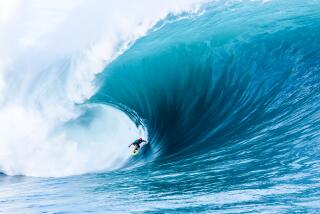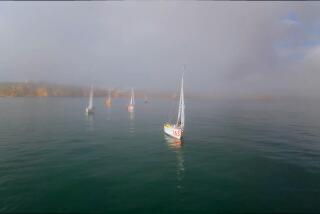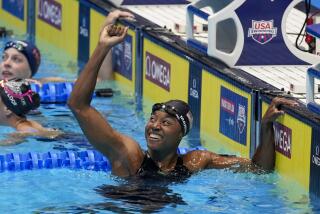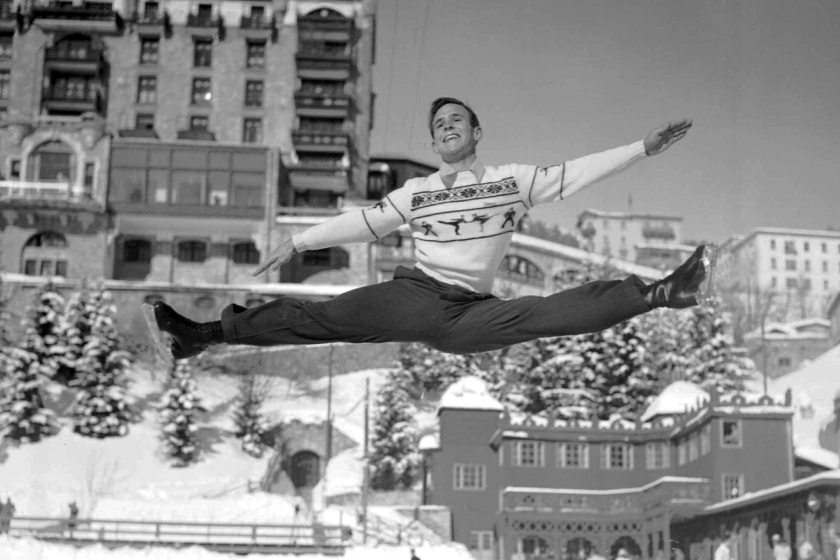U.S. Olympic Sailing Trials : Three-Way Battle in Flying Dutchman Class
- Share via
NEWPORT, R.I. — Judging from these Olympic trials, there are no more than 10 serious Flying Dutchman sailors in the United States, which is about nine more than in a non-Olympic year.
“And the guy that wins had better win a gold medal for the rest of us,” Mike Loeb, Flying Dutchman veteran, said Friday.
Even in such a small class, the 36-year-old real estate salesman from New Haven, Conn., probably won’t be the one. He had his best shot when he won the trials in 1980--the year the United States boycotted the Moscow Games.
The winner will probably emerge from the current top three: Paul Foerster of Corpus Christi, Tex., who leads the scoring with 5.7 points after 3 of a possible 10 races; J.B. Braun of Marblehead, Mass., who has 8.7 points, and Ron Rosenberg of Long Beach, who has 18.7 points.
Including Foerster, the recent European champion, each class here had a second-time winner Friday: John Shadden, Long Beach, in men’s 470; Allison Jolly, Valencia, in women’s 470; Pete Melvin, Long Beach, in Tornado, and 17-year-old Bert Rice Jr., Gulf Breeze, Fla., in sailboard.
All except Rice lead their classes, and he probably will be able to discard Thursday’s 13th-place finish as one of two entitled throwouts.
None will have worked harder than the Flying Dutchman winner. The boat not only is a brute to sail but an expensive brute: about $20,000 apiece, race ready. That’s why Loeb, competing in his fourth trials, is the only man back from the 1984 trials at Long Beach that produced gold medalists Jonathan McKee and crew Carl Buchan.
The Flying Dutchman originated in--you guessed it--the Netherlands in 1951, and became an Olympic class in 1960 after gaining wide popularity in Europe, if not in the United States.
It’s an unballasted dinghy, 19 feet 10 inches long and, if sailed properly, the world’s fastest centerboard dinghy.
But to sail one properly takes practice, skill and strength.
“These are by far the most brutal boats where teamwork is so important,” Ron Rosenberg said. “You have to get 100% from each half to make things come close to working. It’s the most demanding boat I’ve ever sailed.”
Rosenberg’s crew, his brother Steve, said: “It’s been so physically and mentally demanding on both of us, I don’t think it would ever interest me to do it again.”
Braun, who sails with Jim Kenney of Marblehead, Mass., said the effort pays off with performance.
“I like high-performance dinghies going fast,” Braun said, “and I’ve always wanted to go to the Olympics. The boat fits our size for the crew weight that’s needed to sail it. The boat is physically and technically demanding, and you have to keep up with developments. But you make it go by your body.”
Loeb, the Olympic Yachting Committee representative for the class, said: “It’s a boat for young men.”
But Loeb remains so committed, he is competing here even though his crew, Peter Alarie, resigned only three weeks before the start of these trials. Loeb persuaded his ’84 crew, Dave Peck, to return.
After this, Loeb said: “I gotta go back to work. I’ve been away since Thanksgiving.”
If he doesn’t win, he doesn’t care who does.
More important, he said: “I hope it will be the same thing we saw in ‘84, that we’ll band together and help whoever wins. There was a lot accomplished between the trials and the Olympics last time. The whole team got together to help Carl and Jonathan.
“There aren’t very many FDs in the country. You go to Europe and sail in 100-boat fleets. We’re never gonna get that here, so if we don’t work together, nobody wins. The person that wins has got to represent all of us.”
The Finn trials at Marblehead, Mass., tightened up Friday when ’84 runner-up Russ Silvestri of Tiburon placed first, and Brian Ledbetter of San Diego was third, well ahead of series leader Stewart Neff of Cambridge, Mass., who was seventh.
Neff leads Ledbetter, 24.4 points to 24.7, with Silvestri at 31.4.
Olympic Sailing Notes
Pete Melvin and rival Gary Knapp have been so far ahead of the rest of the Tornado fleet that it didn’t matter when the race committee gave them an accidental handicap Friday. Neither was informed when a weather mark was moved a half-mile left because of a wind shift, so they sailed around the old mark and still beat the fleet to the new one. Melvin, who won by about 500 yards, lost the lead and Thursday’s race to Knapp when the wind increased, but held on in similar circumstances this time. “We actually pulled out on him,” Melvin said. “We changed the upper battens in the sail before the start (to de-power it) when we figured the wind was going to pick up.”
Shadden and Foerster played wind shifts well to lead around all the marks, each winning by about a minute. Foerster said his position “is better than I expected.” Shadden was delighted with some new-found speed that allowed him to get in front, “watch other people and not do anything risky.” . . . Allison Jolly swapped the lead three times with Lisa Niece of Vashon, Wash. Then, Jolly’s crew Lynne Jewell said: “We slammed her really hard (tacked on Niece’s wind), so she missed the mark.” Jolly/Jewell hold a 16.7-point lead, the largest in any class. “It makes me nervous, there’s so many races to go,” Jewell said.
More to Read
Go beyond the scoreboard
Get the latest on L.A.'s teams in the daily Sports Report newsletter.
You may occasionally receive promotional content from the Los Angeles Times.






